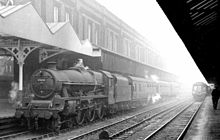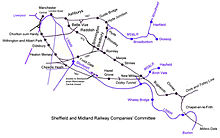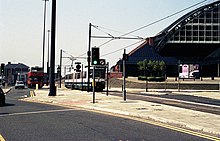Manchester Central Station
On 27 March 2020, the UK government announced that the building would be converted into an emergency hospital, intended to deal with the COVID-19 pandemic and with 1,000 beds. It was opened in April 2020 and closed in March 2021.
History

The station was built between 1875 and 1880 by the Cheshire Lines Committee (CLC), and was officially opened on 1 July 1880. The architect was Sir John Fowler and the engineers were Richard Johnson, Andrew Johnston and Charles Sacré for the three companies which formed the CLC.
While it was being built, a temporary facility, Manchester Free Trade Hall Station (after the Free Trade Hall a landmark building nearby) was in use from 9 September 1877. It had two wooden platforms serving four tracks. When the station opened, the temporary station became Manchester Central Goods.
In 1963, the building was Grade II* listed for its special architectural or historic interest.
Construction details
The station's roof is a single span wrought iron truss structure 550 feet (168 m) long with a span of 210 feet (64 m), and was 90 feet (27 m) high at its apex above the railtracks. Glass covered the middle section, timber (inside) and slate (outside) covered the outer quarters. The end screens were glazed with timber boarding surrounding the outer edges. It was constructed by Andrew Handyside and Co. The substructure and masonry partition were provided by Robert Neill and Sons of Manchester. Underneath the train shed is a large brick undercroft with intersecting tunnel vaults, above which were six platforms above street level which exited the station onto viaducts and bridges. The undercroft was used for storage and connected to the adjacent goods sidings by a carriage lift. The station's two-storey south wall has 15 bays separated by brick pilasters. At ground-floor level the bays have three round-headed windows and at first-floor level three square-headed. In the 20th century a glazed canopy was erected at the entrance at north end.

A temporary wooden building, erected at the front of the station to house ticket offices and waiting rooms was planned to be replaced by a grander edifice, for example a hotel and railway offices as at London St Pancras, but remained in use until the station closed. The Midland Hotel was built by the Midland Railway in 1898–1903 on an adjacent site.
Railway usage


The Midland Railway (MR), one of the CLC's partners, used Manchester Central as its terminus for services including express trains to London St Pancras. Beginning in 1938, the London, Midland and Scottish Railway (successor to the MR) ran two prestige expresses, The Peaks and the Palatine, stopping en route at Chinley, Millers Dale, Matlock, Derby and Leicester.
Between 1960 and 15 April 1966, during the electrification of the West Coast Main Line, Central Station was the terminus for the Midland Pullman, a streamlined blue six-coach diesel multiple unit. This stopped at Cheadle Heath (now closed), before running fast to St Pancras.
Services through Millers Dale finished in July 1968, when the line was closed as a through route. The station provided local services to Chester and Liverpool, but closed to passengers on 5 May 1969, when the remaining services were switched to Manchester Oxford Road and Manchester Piccadilly stations.
| Preceding station | Disused railways | Following station | ||
|---|---|---|---|---|
| Terminus | Cheshire Lines Committee Manchester South District Line |
Chorlton-cum-Hardy Line closed, station open | ||
| Cheshire Lines Committee Manchester to Liverpool Line |
Trafford Park Line closed, station open | |||
| Cheshire Lines Committee Mid-Cheshire Line |
Sale Line closed, station open |
Accidents and incidents
- On 8 June 1939, a passenger train departed against a danger signal and was in collision with another passenger train. Several people were injured.
- In October 1965, detectives who had arrested Ian Brady for the murder of 17-year-old Edward Evans in Hattersley discovered evidence in a left luggage locker at the station. This evidence connected them to the disappearances of two missing children, who were soon discovered to have been murdered by Brady and his accomplice Myra Hindley in the widely reported Moors murders, in which at least five children and teenagers were murdered.
Post-railway era
Dereliction and redevelopment

Over a decade, Central Station fell into a dilapidated state, was damaged by fire and was used as a car park. The property was acquired by Greater Manchester Council and, in 1982, work began on converting it into an exhibition centre, which opened in 1986 as the Greater Manchester Exhibition and Conference Centre or G-Mex. It was subsequently renamed Manchester Central, in honour of its railway history. The undercroft was converted into a car park, serving the centre and Bridgewater Hall.
Light rail

The opening, in 1992, of the Metrolink light rail system has seen the conversion of suburban heavy rail lines such as the former Manchester, South Junction and Altrincham Railway to Altrincham and the disused Cheshire Lines Committee route via Didsbury. With the introduction of Metrolink, rail services from south Manchester ran once more to Central Station. However, instead of trains running into the Central Station arch, light rail vehicles now cross the railway viaduct and stop at Deansgate-Castlefield tram stop. They then run down a ramp which runs parallel to Lower Mosley Street, alongside the south-eastern side of the former train shed, before reaching street level where they operate as trams and head towards St Peter's Square.
Gallery
-
Derelict station in 1981
-
Derelict platforms
-
Platform detail
-
Inside the derelict station
-
Looking towards the platforms
-
GMEX Centre in 2007
-
1894 map showing the location of Central Station
See also
- The Great Northern Warehouse, a former railway building nearby, now a leisure/shopping complex
- Grade II* listed buildings in Greater Manchester
References
- ^ "Coronavirus: Birmingham and Manchester temporary hospitals announced". BBC News. BBC. 27 March 2020. Retrieved 27 March 2020.
- ^ "Covid: NHS Nightingale Hospital North West to 'cease operations in March'". BBC News. 25 February 2021. Retrieved 11 February 2024.
- ^ Historic England (12 May 2002). "G-Mex, Windmill Street (1270514)". National Heritage List for England. Retrieved 10 July 2009.
- ^ Lashley, Brian (5 May 2009). "Manchester Central marks milestone". Manchester Evening News. Archived from the original on 14 January 2013. Retrieved 10 July 2009.
- ^ Manchester Central Station (G-MEX) roof, Engineering Timelines, retrieved 25 November 2011
- ^ Station name: Manchester Central, disused stations.org, retrieved 23 August 2012
- ^ Earnshaw, Alan (1989). Trains in Trouble: Vol. 5. Penryn: Atlantic Books. p. 28. ISBN 0-906899-35-4.
Further reading
- Mitchell, Vic; Smith, Keith (2013). Chester Northgate to Manchester. Middleton Press. figs. 106-118. ISBN 9781908174512. OCLC 892704846.
- Clarke, John (April 1966). "Railway Terminus into Exhibition Hall? - Manchester Central Station of the Cheshire Lines planned for closure". Railway Magazine. Vol. 112, no. 780. pp. 196–199.
External links
- Ellis, Chris (11 January 2015). "What happened to England's forgotten railway stations?". BBC News. Archived from the original on 11 January 2015. Retrieved 11 January 2015.
- A Guide to Civil Engineering in Manchester
- The Lincolnshire & East Yorkshire Transport Review.
Manchester railways |
|---|
City Centre and North
Past, present and future |






